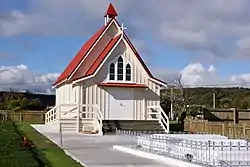Mourea
Mourea is a settlement in Rotorua Lakes within the Bay of Plenty Region of New Zealand's North Island.
Mourea | |
|---|---|
Locality | |
 St Mary's Church, Mourea | |
| Coordinates: 38.045997°S 176.330150°E | |
| Country | New Zealand |
| Region | Bay of Plenty |
| Territorial authority | Rotorua Lakes District |
| Ward | Te Ipu Wai Auraki General Ward |
| Community | Rotorua Lakes Community |
| Electorates | |
| Government | |
| • Territorial authority | Rotorua Lakes Council |
| • Regional council | Bay of Plenty Regional Council |
| Area | |
| • Total | 6.53 km2 (2.52 sq mi) |
| Population (June 2023)[2] | |
| • Total | 430 |
| • Density | 66/km2 (170/sq mi) |
It is located on a thin strip of land between Lake Rotorua and Lake Rotoiti, on State Highway 33.
Demographics
Mourea is described by Statistics New Zealand as a rural settlement, and covers 6.53 km2 (2.52 sq mi)[1] and had an estimated population of 430 as of June 2023,[2] with a population density of 66 people per km2. Mourea is part of the larger Rotoiti-Rotoehu statistical area.[3]
| Year | Pop. | ±% p.a. |
|---|---|---|
| 2006 | 375 | — |
| 2013 | 339 | −1.43% |
| 2018 | 399 | +3.31% |
| Source: [4] | ||
Mourea had a population of 399 at the 2018 New Zealand census, an increase of 60 people (17.7%) since the 2013 census, and an increase of 24 people (6.4%) since the 2006 census. There were 126 households, comprising 198 males and 204 females, giving a sex ratio of 0.97 males per female, with 78 people (19.5%) aged under 15 years, 72 (18.0%) aged 15 to 29, 177 (44.4%) aged 30 to 64, and 72 (18.0%) aged 65 or older.
Ethnicities were 47.4% European/Pākehā, 68.4% Māori, 3.0% Pacific peoples, and 4.5% Asian. People may identify with more than one ethnicity.
Although some people chose not to answer the census's question about religious affiliation, 44.4% had no religion, 34.6% were Christian, 3.8% had Māori religious beliefs, 2.3% were Hindu and 6.0% had other religions.
Of those at least 15 years old, 60 (18.7%) people had a bachelor's or higher degree, and 57 (17.8%) people had no formal qualifications. 36 people (11.2%) earned over $70,000 compared to 17.2% nationally. The employment status of those at least 15 was that 150 (46.7%) people were employed full-time, 51 (15.9%) were part-time, and 24 (7.5%) were unemployed.[4]
Marae
Mourea has three marae.
Taupiri Marae and Paruaharanui meeting house belongs to the Ngāti Pikiao hapū of Ngāti Paruaharanui.[5][6] In October 2020, the Government committed $500,000 from the Provincial Growth Fund to upgrade the marae; it was expected to create 14 jobs.[7]
Waiatuhi Marae and Kahumatamomoe meeting house is a meeting place for Ngāti Rongomai and the Ngāti Pikiao hapū of Ngāti Kahumatamomoe, Ngāti Paruaharanui and Ngāti Te Takinga.[5][6]
Te Takinga pa site includes two buildings: Te Takinga te whare tupuna and Hineora te wharekai.[8][9]
References
- "ArcGIS Web Application". statsnz.maps.arcgis.com. Retrieved 25 December 2022.
- "Subnational population estimates (RC, SA2), by age and sex, at 30 June 1996-2023 (2023 boundaries)". Statistics New Zealand. Retrieved 25 October 2023. (regional councils); "Subnational population estimates (TA, SA2), by age and sex, at 30 June 1996-2023 (2023 boundaries)". Statistics New Zealand. Retrieved 25 October 2023. (territorial authorities); "Subnational population estimates (urban rural), by age and sex, at 30 June 1996-2023 (2023 boundaries)". Statistics New Zealand. Retrieved 25 October 2023. (urban areas)
- 2018 Census place summary: Rotoiti-Rotoehu
- "Statistical area 1 dataset for 2018 Census". Statistics New Zealand. March 2020. 7014666 and 7014668.
- "Te Kāhui Māngai directory". tkm.govt.nz. Te Puni Kōkiri.
- "Māori Maps". maorimaps.com. Te Potiki National Trust.
- "Marae Announcements" (Excel). growregions.govt.nz. Provincial Growth Fund. 9 October 2020.
- "Te Arawa mourns kaumatua". New Zealand Media and Entertainment. Rotorua Daily Post. 8 March 2011.
- Godber, Albert Percy. "Te Takinga meeting house at Te Takinga Marae, Mourea, Lake Rotorua". natlib.govt.nz. National Library of New Zealand.